- MOE
- National Parks of Japan
- Aso-Kuju National Park
- Characteristics
main body
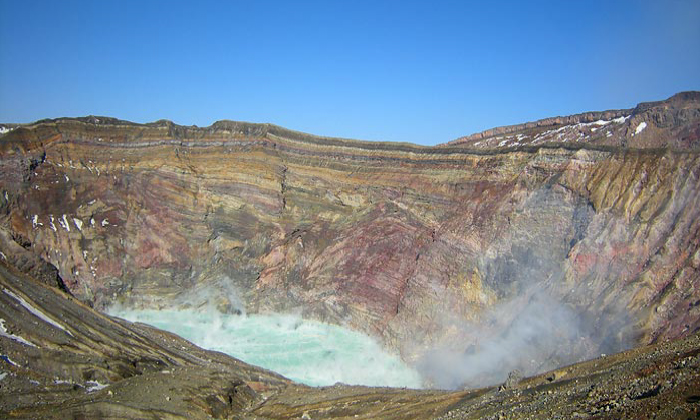
Characteristics
The scent of Grasslands, the breath of volcanoes. The blessing of the wind and water, connected by people, a land of wonder
Date of Designation: December 4, 1934
Area: 73,017 ha
Related Prefectures: Kumamoto, Oita
Area: 73,017 ha
Related Prefectures: Kumamoto, Oita
The main characteristics of the park include a huge caldera encompassing the five peaks of Mount Aso, along with the Kuju Mountain Range located to the north, and magnificent and gentle grasslands surrounding them.
In the southern part of the park, visitors can admire a series of breathtaking scenery, including the fuming crater of Mount Nakadake, the beautiful cone of Komezuka, the vast grassland of Kusasenri Ga Hama, as well as the caldera in which they are situated.
Around the Kuju Mountain Range, visitors will find various volcanic phenomena scattered throughout the area, creating unique volcanic landscapes. There are numerous highlights, including the vast grasslands of the Kuju and Handa plateaus, as well as the academically valuable wetlands of Tadewara Marsh and Bogatsuru Marsh.
In the northern part of the park, the beautiful shapes of Mount Tsurumi and Mount Yufudake, the sources of hot springs in Beppu and Yufuin, can be appreciated. From the mountain ridges, visitors can enjoy a panoramic view stretching from Beppu Bay to the Yufuin Basin and the Kuju Mountain Range.
In the southern part of the park, visitors can admire a series of breathtaking scenery, including the fuming crater of Mount Nakadake, the beautiful cone of Komezuka, the vast grassland of Kusasenri Ga Hama, as well as the caldera in which they are situated.
Around the Kuju Mountain Range, visitors will find various volcanic phenomena scattered throughout the area, creating unique volcanic landscapes. There are numerous highlights, including the vast grasslands of the Kuju and Handa plateaus, as well as the academically valuable wetlands of Tadewara Marsh and Bogatsuru Marsh.
In the northern part of the park, the beautiful shapes of Mount Tsurumi and Mount Yufudake, the sources of hot springs in Beppu and Yufuin, can be appreciated. From the mountain ridges, visitors can enjoy a panoramic view stretching from Beppu Bay to the Yufuin Basin and the Kuju Mountain Range.
Terrain/Landscape

Mt. Nakadake Central Crater
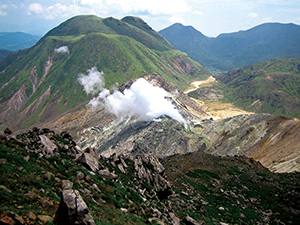
Kuju Mountain Range and Its Solfataric Phenomena
Mount Aso has one of the world's largest calderas, measuring approximately 25 kilometers from north to south and 18 kilometers from east to west.
The central volcanic cone group, known as Aso Gogaku or the five peaks of Mount Aso, includes Mount Takadake as its highest point, reaching a height of 1,592 meters.The landscape near the crater of Mount Nakadake, one of the most active volcanoes in Japan, is rugged; as you move away from the crater rim, the terrain transforms into grasslands with abundant plants, creating a more serene scene.
The Kuju Mountain Range features peaks like Mount Nakadake (the highest at 1,791 meters). Notably, this Mount Nakadake is different from the one among the five peaks of Mount Aso, despite sharing the same name. In the north and south of the mountain range, there are volcanic plateaus formed by volcanic ash and other materials, presenting magnificent grassland landscapes. The area also features numerous depressions and abundant springs, resulting in many marshes. The contrast between the volcanoes and grasslands is one of the major attractions for visitors to this national park.
The central volcanic cone group, known as Aso Gogaku or the five peaks of Mount Aso, includes Mount Takadake as its highest point, reaching a height of 1,592 meters.The landscape near the crater of Mount Nakadake, one of the most active volcanoes in Japan, is rugged; as you move away from the crater rim, the terrain transforms into grasslands with abundant plants, creating a more serene scene.
The Kuju Mountain Range features peaks like Mount Nakadake (the highest at 1,791 meters). Notably, this Mount Nakadake is different from the one among the five peaks of Mount Aso, despite sharing the same name. In the north and south of the mountain range, there are volcanic plateaus formed by volcanic ash and other materials, presenting magnificent grassland landscapes. The area also features numerous depressions and abundant springs, resulting in many marshes. The contrast between the volcanoes and grasslands is one of the major attractions for visitors to this national park.
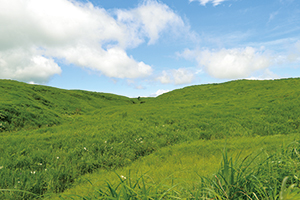
Aso's Grasslands
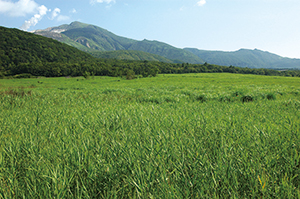
Tadewara Marsh
There are volcanic plateaus formed by volcanic ash and other materials in its north and south, presenting magnificent grassland scenery. There also are many dips that have developed into a lot of moors by abundant spring water and rainfall. Such a contrast of volcano and grasslands is one of the major attractions for visitors to this park.
Plants
The park's ecology can be classified into three main types: areas characterized by volcanic vents emitting sulfurous gases, known as solfataric wilderness; forests at the foot of mountains; and grasslands maintained through controlled burning and mowing.
The solfataric wilderness has a peculiar biota where animals and plants have adapted to the harsh environment. Around the volcano, the effects of volcanic gas give rise to unique plant formations, such as clusters of Kyushu Azalea and Cowberry, creating a particular and scenic landscape.
The forests in the park, including natural and secondary forests, support a wide variety of animals and plants. These forests provide essential habitats and resources for a diverse range of species.
The grasslands exhibit different vegetation patterns depending on human usage and management practices. This includes tall-grass vegetation dominated by Japanese silver grass, maintained through continued controlled burning and mowing, as well as short-grass vegetation, managed through the pasturing of cows and horses. Each type of vegetation fosters specific ecological conditions that support distinct animals and plants.
The solfataric wilderness has a peculiar biota where animals and plants have adapted to the harsh environment. Around the volcano, the effects of volcanic gas give rise to unique plant formations, such as clusters of Kyushu Azalea and Cowberry, creating a particular and scenic landscape.
The forests in the park, including natural and secondary forests, support a wide variety of animals and plants. These forests provide essential habitats and resources for a diverse range of species.
The grasslands exhibit different vegetation patterns depending on human usage and management practices. This includes tall-grass vegetation dominated by Japanese silver grass, maintained through continued controlled burning and mowing, as well as short-grass vegetation, managed through the pasturing of cows and horses. Each type of vegetation fosters specific ecological conditions that support distinct animals and plants.
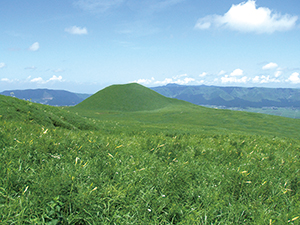
Grassland (tall-grass type) Used as a Meadow
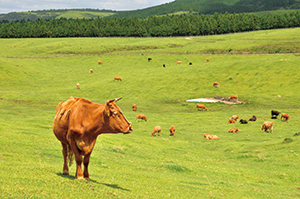
Grassland (short-grass type) Used for Pasturing
Additionally, these grasslands serve as valuable habitats for numerous rare and endangered species, including and Iris rossii, which are able to thrive due to the controlled management practices. The Tadewara Marsh and other marshes are home to academically valuable vegetation, including clusters of Lobelia sessilifolia, Moliniopsis Japonica and other plants.
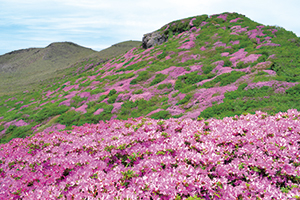
Community of Rhododendron kiusianum (Mt. Takadake)
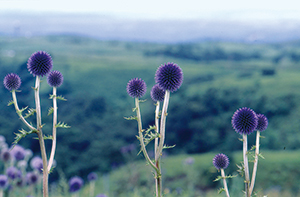
Echinops setifer
Wildlife
In this area, you can find various fascinating creatures, such as butterflies, including rare species like Shijimiaeoides divinus asonis, which feeds on Shrubby sophora (a type of plant), and Maculinea teleius, which feeds on Great Burnet (a flowering plant).
The forests are inhabited by insects like the Lyristes kyushyuensis,and the grasslands are home to Copris ochus. Many bird species adapted to grassland habitats can be spotted here, including the Meadow Bunting, Chestnut-eared Bunting, Zitting Cisticola, Japanese Reed Bunting, and Black-browed Reed Warbler.
Additionally, You might also see birds of prey like the Eastern Buzzard and Japanese Sparrowhawk.
Other creatures include the Japanese Odd-scaled Snake and Tiger Keelback, as well as amphibians like Spotted Salamander, and Kajika frog.
The forests are inhabited by insects like the Lyristes kyushyuensis,and the grasslands are home to Copris ochus. Many bird species adapted to grassland habitats can be spotted here, including the Meadow Bunting, Chestnut-eared Bunting, Zitting Cisticola, Japanese Reed Bunting, and Black-browed Reed Warbler.
Additionally, You might also see birds of prey like the Eastern Buzzard and Japanese Sparrowhawk.
Other creatures include the Japanese Odd-scaled Snake and Tiger Keelback, as well as amphibians like Spotted Salamander, and Kajika frog.
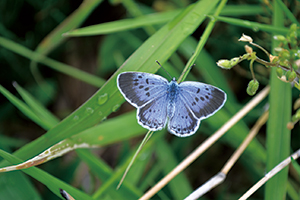
Shijimiaeoides divinus
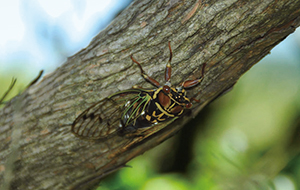
Kyushu-ezozemi
Culture
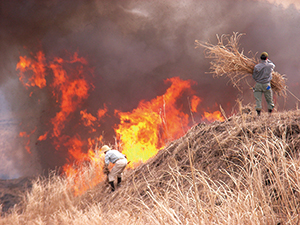
Controlled Burn (in spring)
Controlled Burning
Every spring, the grasslands are intentionally burned. This practice has been ongoing for over a thousand years to prevent the grasslands from turning into forests and to utilize them as pasture and Japanese silver grass fields.

One of the Major Onsen Areas (Sujiyu Onsen, "Japan's best pelting hot water")
Hot springs
Thanks to the volcanic activity, the area is blessed with many onsen (hot springs) appreciated by local residents and tourists since ancient times. Set against the picturesque landscapes of Aso, these natural hot springs offer a serene escape. Visitors immerse themselves in therapeutic waters, believed to possess healing properties due to their mineral content. Onsen establishments boast unique charm, situated in secluded areas or offering panoramic mountain views.
